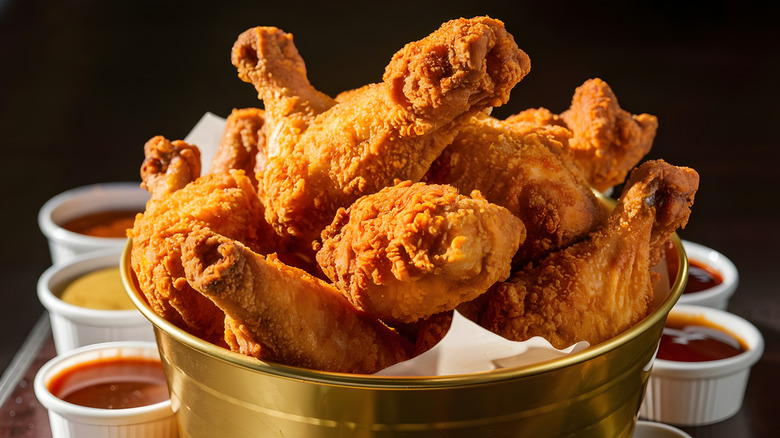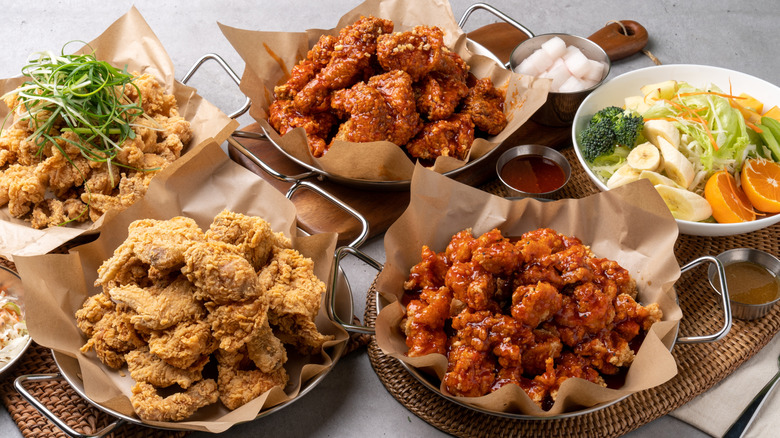What's The Difference Between American And Korean Fried Chicken?
Few dishes are more universal than fried chicken. It's been with us as a people since the Roman Empire — and as society has evolved, so have techniques for perfecting the cooking process. Many cultures have their take on fried chicken, but two of the most popular are American and Korean fried chicken. So what's the difference between these two iconic meals?
The main difference is the way that the meat is fried, and the texture that ensues from that process. Classic American fried chicken involves soaking the meat in buttermilk before coating it in a wheat flour-based dredge that includes spices like paprika and garlic powder. The chicken is then fried in oil.
Korean fried chicken, on the other hand, is seasoned and coated in a wet batter made from potato or corn starch and either tempura mix or seasoned flour. The chicken is fried at lower temperatures to create an insulating layer that keeps the meat moist, then fried a second time at higher temperatures to reach that perfect, extra-crunchy exterior that has made the dish a worldwide phenomenon.
American fried chicken is generally served with sauce on the side
It's generally believed that the American origins of fried chicken owe some credit to Scottish immigrants in the 18th century. The Scots were known for their technique of battering their chickens and pan-frying them in pork lard, but they were also known to barely season their batter. As the dish spread in America, enslaved people of West African descent, incorporating elements from a different culinary tradition more similar to fricassée, where chicken is lightly fried and then braised in sauce, began adding spices and making the dish something new and unique.
Pioneers like Edna Lewis helped push forward both the preparation and frying process. She used a combination of brining and buttermilk to infuse flavor into the bird, then fried it in a combination of lard, butter, and the fat rendered off country ham that has been boiled in the lard-butter combination. This creates an explosion of flavor when the dredged chicken is removed: seasoned, crunchy, and perfect exactly as is, with no sauce required.
This leads us to the second main difference between these two culinary practices: how the chicken is served. While there are exceptions such as Nashville hot chicken and Teddy Roosevelt's beloved country-fried chicken, which is smothered in white gravy, the common practice is to serve American fried chicken dry, and if there are any sauces, to serve them on the side. This is very different from the Korean practice of dunking the chunks of chicken into a number of sauces and serving them wet, sticky, and delicious.
Korean fried chicken: a dish of infinite variations
Flash forward to the 1950s — when Korean fried chicken was invented on the battlefield. American soldiers in the Korean War wanted to make Thanksgiving dinner, but with no turkeys on hand, fried chicken instead, sharing the meal with their Korean compadres. Until then, it was more common to steam or boil chicken in South Korea, but this dish caught on quickly, especially once the practice of liberally saucing the meat entered the fray.
By the 1980s, fried chicken in gochujang had become popular, but it was the 1997 financial crisis that caused recently unemployed South Koreans to open chicken joints, skyrocketing the dish's prestige and leading to the many variations of what we now know as Korean fried chicken. This also prompted the rise of chimaek, the practice of pairing fried chicken with beer and cubes of pickled radish.
One of the true beauties of South Korea's take on the dish is that there's a sauce for every taste preference. Dakgangjeong is a sweet and spicy sauce made from gochujang, soy sauce, and garlic. This is similar to another popular chicken style, yangnyeom — one of many international styles of fried chicken worth traveling for – but thicker given the use of brown sugar and corn syrup or honey. Bburinkle is an oniony dry chicken topped with dehydrated cheese and dipped into a semi-sweet yogurt sauce. Padak is a scallion-topped chicken coated in a light sauce reminiscent of vinaigrette. For those who can't choose, there's always the option of ordering banban, or half-half.



